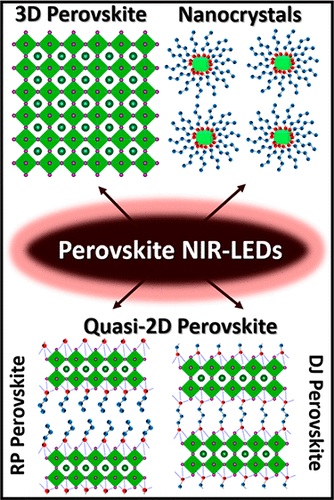当前位置:
X-MOL 学术
›
ACS Appl. Electron. Mater.
›
论文详情
Our official English website, www.x-mol.net, welcomes your feedback! (Note: you will need to create a separate account there.)
Recent Advancements in Near-Infrared Perovskite Light-Emitting Diodes
ACS Applied Electronic Materials ( IF 4.7 ) Pub Date : 2020-10-27 , DOI: 10.1021/acsaelm.0c00825 Parth Vashishtha 1, 2 , Swati Bishnoi 3, 4 , C.-H. Angus Li 5 , Metikoti Jagadeeswararao 2 , Thomas J. N. Hooper 6 , Naina Lohia 3, 4 , Sunil B. Shivarudraiah 5 , Mohammed S. Ansari 1 , Shailesh N. Sharma 3, 4 , Jonathan E. Halpert 5
ACS Applied Electronic Materials ( IF 4.7 ) Pub Date : 2020-10-27 , DOI: 10.1021/acsaelm.0c00825 Parth Vashishtha 1, 2 , Swati Bishnoi 3, 4 , C.-H. Angus Li 5 , Metikoti Jagadeeswararao 2 , Thomas J. N. Hooper 6 , Naina Lohia 3, 4 , Sunil B. Shivarudraiah 5 , Mohammed S. Ansari 1 , Shailesh N. Sharma 3, 4 , Jonathan E. Halpert 5
Affiliation

|
Metal halide perovskites have shown excellent properties for lighting applications, including high photoluminescence quantum yield (PLQY), compositional tunability, and narrow emission line widths. Perovskite light-emitting diodes (LEDs) have achieved external quantum efficiency (EQE) up to 20% in the green, red, and near-infrared (NIR) spectral regions. Recently, nanostructured perovskite NIR-LEDs have displayed 100 h of device stability, making this technology commercially viable and prompting greater awareness of this class of devices, as distinct from visible wavelength perovskite LEDs. Even so, the current generation of high-performance perovskite LEDs are still hampered by slow radiative recombination of charge carriers, unbalanced injection of charge carriers, and light out-coupling efficiency; therefore, more structural and morphological engineering of perovskite LEDs is needed to confine the charge carriers and collect the photons more effectively. It has been observed that 3D bulk perovskites show high performance but have poor stability and offer less control over their optical properties. In contrast, NIR-emitting perovskite nanocrystals offer precise control of their optical properties but exhibit poor optoelectronic properties due to the presence of bulky ligands. Quasi-2D perovskite systems have gained significant attention as they balance high conductivity and stability, while enabling precise color tuning of nanostructures, and the possibility to produce single crystal-LEDs. Here, we assess these and other recent advancements in NIR-emitting perovskite materials. We compare different structural frameworks and how they influence the LED performance in terms of color stability, EQE, and device stability. The practical challenges facing each of these structural classes of perovskite NIR-LED materials and the possible strategies to overcome these obstacles are thoroughly discussed.
中文翻译:

钙钛矿型近红外发光二极管的最新进展
金属卤化物钙钛矿在照明应用中显示出优异的性能,包括高光致发光量子产率(PLQY),组成可调性和窄的发射线宽度。钙钛矿发光二极管(LED)在绿色,红色和近红外(NIR)光谱区域中已达到高达20%的外部量子效率(EQE)。近来,纳米结构的钙钛矿NIR-LED已显示出100 h的设备稳定性,这使得该技术在商业上可行,并且与可见光波长的钙钛矿LED有所不同,促使人们对该类设备有了更多的了解。即便如此,当前一代的高性能钙钛矿LED仍然受到电荷载流子的缓慢辐射复合,电荷载流子注入不平衡以及光输出耦合效率的阻碍。因此,需要更多钙钛矿LED的结构和形态工程,以限制电荷载流子并更有效地收集光子。已经观察到3D块状钙钛矿显示出高性能,但是稳定性差并且对其光学性质的控制较少。相反,发射NIR的钙钛矿纳米晶体可精确控制其光学性能,但由于存在大量配体而显示出较差的光电性能。准2D钙钛矿系统已经获得了广泛的关注,因为它们平衡了高电导率和稳定性,同时可以对纳米结构进行精确的颜色调整,并具有生产单晶LED的可能性。在这里,我们评估了近红外发射钙钛矿材料的这些和其他最新进展。我们比较了不同的结构框架以及它们如何影响颜色稳定性,EQE和设备稳定性的LED性能。钙钛矿NIR-LED材料的每种结构类别面临的实际挑战以及克服这些障碍的可能策略均得到了全面讨论。
更新日期:2020-11-25
中文翻译:

钙钛矿型近红外发光二极管的最新进展
金属卤化物钙钛矿在照明应用中显示出优异的性能,包括高光致发光量子产率(PLQY),组成可调性和窄的发射线宽度。钙钛矿发光二极管(LED)在绿色,红色和近红外(NIR)光谱区域中已达到高达20%的外部量子效率(EQE)。近来,纳米结构的钙钛矿NIR-LED已显示出100 h的设备稳定性,这使得该技术在商业上可行,并且与可见光波长的钙钛矿LED有所不同,促使人们对该类设备有了更多的了解。即便如此,当前一代的高性能钙钛矿LED仍然受到电荷载流子的缓慢辐射复合,电荷载流子注入不平衡以及光输出耦合效率的阻碍。因此,需要更多钙钛矿LED的结构和形态工程,以限制电荷载流子并更有效地收集光子。已经观察到3D块状钙钛矿显示出高性能,但是稳定性差并且对其光学性质的控制较少。相反,发射NIR的钙钛矿纳米晶体可精确控制其光学性能,但由于存在大量配体而显示出较差的光电性能。准2D钙钛矿系统已经获得了广泛的关注,因为它们平衡了高电导率和稳定性,同时可以对纳米结构进行精确的颜色调整,并具有生产单晶LED的可能性。在这里,我们评估了近红外发射钙钛矿材料的这些和其他最新进展。我们比较了不同的结构框架以及它们如何影响颜色稳定性,EQE和设备稳定性的LED性能。钙钛矿NIR-LED材料的每种结构类别面临的实际挑战以及克服这些障碍的可能策略均得到了全面讨论。

























 京公网安备 11010802027423号
京公网安备 11010802027423号